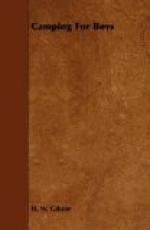(4) add the pillow;
(5) fold the blankets over you and pin them with big safety pins across the bottom and along the side.
To Keep Warm
Stewart Edward White in “Camp and Trail” tells how to keep warm when sleeping on the ground: “Lie flat on your back. Spread the blanket over you. Now raise your legs rigid from the hip, the blanket, of course, draping over them. In two swift motions tuck first one edge under your legs from right to left, then the second edge under from left to right, and over the first edge. Lower your legs, wrap up your shoulders and go to sleep. If you roll over, one edge will unwind but the other will tighten.”
A bed tick[1] 6-1/2 feet long and 2-1/2 feet wide, to be filled with grass, leaves, straw or any available stuff makes a comfortable bed.
[Transcribers Footnote 1: Cloth case for a mattress or pillow or a light mattress without springs.]
To Make a Bed
A comfortable bed used at Camp Durrell, is made by driving four posts in the ground and nailing a frame work of saplings on these posts. Rope is then interwoven from side to side in somewhat the fashion of the old-time cord bed. Pine boughs are then placed “shingle” fashion in the cording, making a very comfortable bed.
Double-Deck Bunks
Many of the long-term camps, however, have cots or bunks with canvas bottoms. This is the best way to sleep for boys who are going to be in camp the entire summer. The following type of double-deck bunk is in use at Camps Adirondack, Becket, Wawayanda and Dudley. The illustrations give a clear idea of its construction. Use wood as free from knots as possible. Spruce seems to be the best kind as it is both light in weight and very durable. The top section upon which the canvas beds are tacked is bolted to the uprights which makes a bunk easily taken apart. Three of these uprights, one at each end and one in the middle, will make a bed section accommodating four boys, two on the “first floor” and two on the “second floor.” In this manner eight boys may be comfortably housed in a 12 x 14 or 14 x 16 foot tent, with room for baggage in the center, as shown in the illustration on page 37.
Blankets
Always remember that to keep warm while sleeping in a cot or bunk, you must have as much thickness of blanket under you as above you. Usually boys will pile blankets on top of them and have only one blanket under them and then wonder why they are cold.
Pillows
A pillow may be made out of a bag of muslin or dark denim and stuffed with a sweater or extra clothing. Much better—take a small pillow with you with removable and washable “case” made of dark green or brown denim.
[Illustration: Bunk Diagram]
Kitchen Ware
In purchasing kitchen ware, a mistake is frequently made by getting a cheap kind of ware unfitted for the hard usage of camp life. The kind manufactured for hotels and restaurants and of sufficient capacity, is more expensive, but will outwear two outfits of the cheaper type and is really more economical in the long run. In the buying do not omit that most adaptable and convenient of all cooking utensils for camp—a wash boiler. Get one that is copper-lined and made of the heaviest tin.




